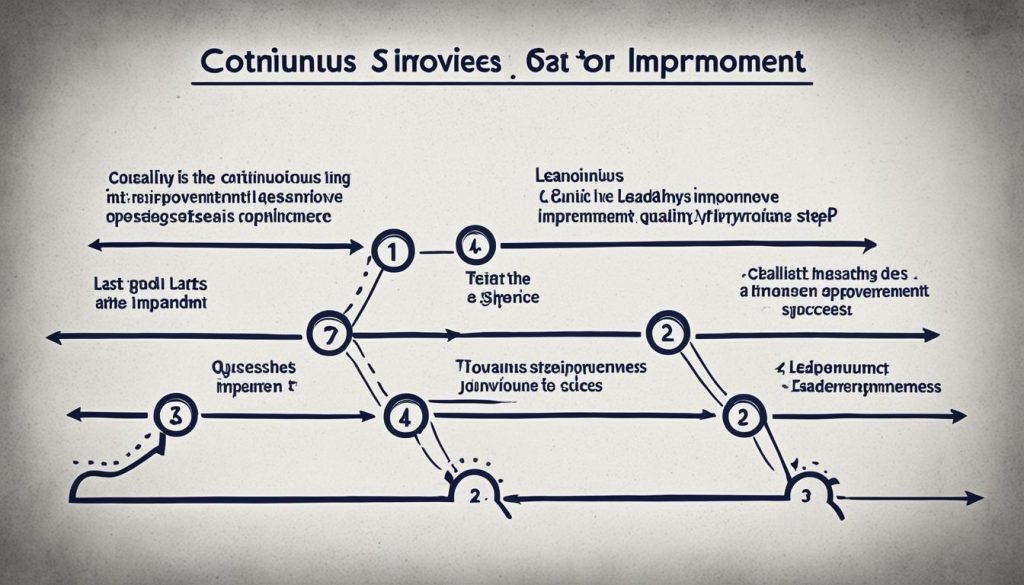Welcome to our complete guide on management best practices. This article explores effective strategies and techniques for leadership. Whether you’re a seasoned leader or a new manager, you’ll find lots of helpful information here.
Being a good leader means having many traits and skills. These include good communication and emotional intelligence. Leaders also need to be adaptable and make decisions. They always look to get better, learn from what they do, and motivate their teams.
Building trust is key for any leader. It’s the basis of a strong relationship between leaders and their teams. This trust lets leaders rely on their teams and assign tasks with confidence. Team members, in turn, feel more empowered and motivated to do well.
Making real connections with your team is also important. Knowing and valuing both their personal and professional sides helps. It makes team members feel more responsible and motivated.
Cultivating a positive work culture is vital as well. This means promoting things like being open, including everyone, and working together. Leaders need to show by doing and help create the culture they want for their teams.
Finally, having a clear vision is key in leadership. Communicating this vision well inspires team members. It gives them a sense of why they are working and what they’re aiming for.
In the next sections, we’ll go deeper into these key management practices. We’ll discuss how you can put these strategies to work in your leadership role. So, let’s begin!
Key Takeaways:
- Effective leadership requires a combination of qualities and skills.
- Trust is crucial in leadership, fostering strong relationships and empowering team members.
- Genuine connections with team members promote responsibility and motivation.
- A positive work culture is essential, promoting transparency, inclusivity, and collaboration.
- Visionary leadership inspires teams towards long-term success.
Personalized Leadership Approach for Each Team Member
Effective leadership involves tailoring how you lead to each person and situation. Good leaders know everyone has different strengths and weaknesses. They use this knowledge to lead in ways that fits everyone.
By understanding what each team member needs, leaders can help them succeed. They change how they talk, inspire, and manage to help each person achieve their goals. This makes their team members more successful.
Leaders help their team grow by adjusting how they lead. Each person can succeed more when their leader knows and supports them well.
Communication and Personalization
Listening and understanding are key in leadership. Leaders hear their team members out and create a place where they can speak freely. This helps leaders give advice and direction that really works for each person.
“Effective communication is not just about speaking; it’s about understanding and showing empathy towards others.”
Good leaders know, everyone likes to be led differently. They offer guidance in various ways to suit what each team member needs. Some need clear instructions, others prefer more freedom to work.
The Benefits of Customization
Customized leadership builds trust and respect in a team. It makes each team member feel important and appreciated. This makes the team work together better, with more energy and focus.
It also makes sure every team member gets the support they need to grow. This way, every person has a chance to do their best, which is fair and makes the team stronger.
Customizing leadership helps leaders use their team’s full power. By knowing each person’s strength, leaders can assign tasks that match what they are good at. This makes the team more effective and efficient.
Continuous Learning and Improvement
Great leaders are always learning and getting better. They listen to feedback and think about what they can do better. They stay open to new ideas, making their leadership style even better over time.
To keep their team strong, leaders always work to improve their own skills as well. They keep up with what’s new in their field, and always look for ways to become better leaders.
A customized leadership style does a lot. It helps every team member do their best, makes the team grow, and leads to success. By valuing what makes each person special, leaders can really help their team shine.
Building Trust and Genuine Connections
Trust is key in leading effectively. It forms the base for a team to respect each other and work together. A good leader earns the trust of their team. They believe in their team members, which makes them feel confident and boosts their drive to do well.
To gain trust, match tasks to each team member’s skills. This lets them feel they are making a valuable contribution. It also makes them trust their leader’s choices more. They will want to do their best, knowing their leader supports them. Trust deepens when everyone’s skills are used well.
Getting to know your team on a personal and professional level is crucial. It lets you create a workplace full of support and inclusion. You can do this by chatting one-on-one, holding social activities, and arranging special talks for feedback.
Team-building activities and social gatherings are great for creating bonds outside work. They provide a setting for people to relax and communicate more freely. This can lead to stronger connections and trust among team members. Sharing personal experiences and life goals at these times strengthens the team’s unity.
Checking in individually with your team also fosters deep connections. This shows you care about their personal and career growth. Leaders can use this time to give advice, share feedback, and discuss any concerns. These talks deepen the trust and respect team members have for their leader.
Beyond these acts, remember to always stay engaged and caring as a leader. It’s an ongoing effort that needs your attention and compassion. By putting in the work to build trusting relationships, leaders set their teams up for success.
Cultivating a Positive Work Culture
Having a positive work culture is vital for good leadership. It creates the basis for a hardworking, inspired team. This culture encourages new ideas and makes employees happier. It revolves around key values like transparency, inclusivity, and collaboration.
Leaders greatly impact the culture of their workplaces. They show the way by their actions. Open sharing about decision-making processes and the reasons behind choices helps. It builds trust and lets everyone share their thoughts openly.
A work culture that includes everyone is important. It values differences and the special skills each person brings. Encouraging opportunities for participation and ensuring everyone’s voice is important helps. It makes people feel part of a team and allows them to shine, no matter their background.
Encouraging teamwork is also a big part of a positive workplace. It allows people to combine their strengths and create together. This approach makes everyone feel responsible for their part. It also drives innovation and problem-solving.
Focusing on a positive work culture makes a team stronger. It helps solve problems better, lowers conflicts, and makes team work better.
| Benefits of a Positive Work Culture | How Leaders Can Cultivate a Positive Work Culture |
|---|---|
| 1. Increased employee satisfaction and engagement | 1. Lead by example and demonstrate desired cultural values |
| 2. Improved collaboration and teamwork | 2. Be transparent about decision-making processes |
| 3. Enhanced creativity and innovation | 3. Create opportunities for participation and inclusivity |
| 4. Reduced employee turnover | 4. Promote diversity and embrace different perspectives |
| 5. Increased productivity and performance | 5. Encourage collaboration and provide resources for teamwork |
A great work culture is good for both workers and the company. It builds a place where people can do their best. For a leader, creating the right work atmosphere is key. It sets the path for the team’s future success.
Becoming a Visionary Leader
Visionary leadership is key for long-term success and setting direction in your team. A crucial part is having a clear vision and sharing it. This inspires and motivates your team.
Align your goals with the company’s mission. Know the company’s values and objectives to set challenging yet reachable goals. This helps in the company’s long-term growth.
Challenging yourself and your team is vital. Pushing limits, and inspiring creativity, fosters continuous improvement. This leads to a team ready to adapt and innovate.
“Leadership is the capacity to translate vision into reality.”
– Warren Bennis
Effective Communication for Visionary Leadership
Communication is crucial for visionary leaders. It’s important to clearly share your vision, goals, and expectations. This helps everyone know their work’s direction and purpose.
Listening actively is key too. Listen to ideas, concerns, and feedback. This makes for a team where everyone feels their input matters.
Being honest and open builds trust in your team. Share decisions, information, and updates regularly. This makes your team believe in your common goal.
Embracing Long-Term Goals
Focus on long-term goals aligned with your organization’s vision. Create strategic objectives and a clear path to reach them. This gives your team a clear purpose and drive.
But, it’s crucial to set goals that are both ambitious and realistic. Realistic goals prevent your team from feeling overwhelmed. It helps achieve steady progress towards your vision.
| Benefits of Visionary Leadership | Key Actions |
|---|---|
| Inspires creativity and innovation | Encourage brainstorming sessions and create an environment that values new ideas. |
| Builds a sense of purpose | Articulate the larger purpose behind the team’s work and show how it contributes to the organization’s vision. |
| Increases team motivation | Recognize and reward achievements, provide opportunities for growth and development. |
| Attracts and retains top talent | Create a positive work culture and reputation that aligns with the values of potential employees. |
Become a visionary leader to inspire your team. This leads to greater heights, a culture of innovation, and lasting success for your organization.
Prioritizing Clear Communication
Effective leadership is built on clear, transparent communication. With it, leaders lay a solid foundation for teamwork. This fosters trust and boosts everyone’s work.
Clear communication is more than just telling things. It means listening, giving feedback, and being open. Leaders should really listen to their team. This makes conversations better and encourages sharing.
Feedback is crucial for good communication, too. It lets leaders offer advice and praise. When given clearly and kindly, feedback helps everyone improve. It should go both ways, though. Leaders need to ask for their team’s thoughts, too.
Being open and honest is key to good leadership. This builds trust and makes a welcoming team. Openness also helps solve problems, as everyone has the facts to work with.
Leaders need to keep their communication open and regular. Updates, meetings, and talks help clear up any issues. Being available and easy to approach is important. It makes everyone feel they can ask anything or suggest ideas.
Good communication is an ongoing effort for any leader. But with the right approach, it strengthens the team and drives the organization’s success.
Encouraging Feedback and Continuous Improvement
Feedback is key in strong leadership. It helps leaders know what their team needs. They listen to feedback to show they care and to build respect. This honest talk gives them insights to solve problems and take smart steps.
Creating a safe space for feedback is important. Leaders make it open for their team to speak freely. They use things like reviews and coaching for feedback. They stress that open, honest talk is a must. This helps everyone share ideas for getting better.
“Feedback is the breakfast of champions.” – Ken Blanchard
In leadership, getting better all the time is a must. Leaders who think there’s always something to learn do best. They find ways to grow their skills and styles. Being ready for change helps them handle new trends and challenges well.
Having a learning attitude is good for the whole team too. When leaders show they’re still learning, their teams follow. This boosts learning across the organization, helping everyone grow.
Promoting a Growth Mindset
To grow a team’s mindset, leaders should:
- Encourage facing challenges as chances to grow.
- Offer resources for team learning and skill betterment.
- Reward the effort and the will to do better, not just results.
- Create a culture where trying hard and learning from mistakes are valued.
- Set goals that push the team to get better and grow.
By focusing on growth and feedback, leaders build a team that always aims for high achievement.

Conclusion
Being a good leader is key for any group to do well. We need to think about leadership in a full way to succeed. Groups get better leaders by giving them the right training, letting them learn by doing, and setting up plans to help them grow.
By making sure leaders are well-prepared, teams can handle what’s coming next. Training helps leaders think wisely, encourage their teams, and push for better outcomes.
Leaders need to keep learning and growing all the time. Organizations can make this happen by teaching everyone to be leaders and keeping a culture of always wanting to learn more. With strong leaders, new ideas and hard work flourish. This makes a place where everyone can do their best.
Getting better at leadership is something that never stops. With smart strategies and always trying to get better, groups can be ready for whatever comes next. Good leadership training kick-starts the process of finding strong leaders, helping the company grow and do well in the future.





